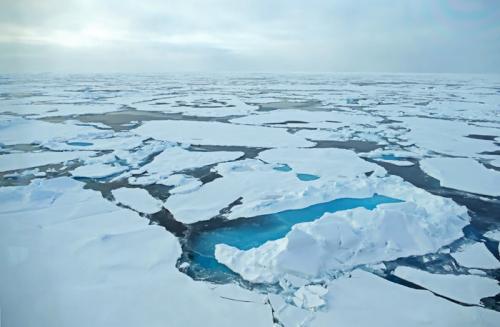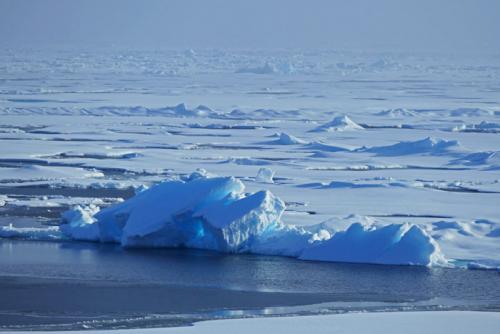Cruise Day 15
Speed 0 knot (kts) (on station)
Course n/a
Location Mendeleev Rise, approx. 375nm NE of Jeannette Island, Russia
Depth 2042 m
GO DEEPER DISCUSSION: (see previous journal for the questions.)
Riddle Answer: The Ocean
TODAY’S JOURNAL:
We’ve made it farther north today, with the scenery taking a turn for the icy last evening. It quickly went from mostly open ocean with drifting ice floes before dinner to mostly ice with some open leads here and there after dinner. However, the ice hasn’t been too thick or tough yet so we made good time to today’s full science station. We began sampling just before noon and should be on station until about noon tomorrow. We briefly crossed over 80° N. Latitude (the station was targeted to be at 80°N, 175° W), but while on station we’ve slowly drifted just a wee bit south of the line. To give my typing fingers and your reading eyes a bit of a break today, I’ll leave you with some pictures of the amazing scenery I’ve been soaking in over the last 24 or so hours. Enjoy!
 Many of the small leads have frozen over, and if the pack ice on each side squeezes this thin ice, finger joints will develop. Note the nearly right angles that form in the cracks as segments of the thin ice overlap as the segments are forced over and under each other.
Many of the small leads have frozen over, and if the pack ice on each side squeezes this thin ice, finger joints will develop. Note the nearly right angles that form in the cracks as segments of the thin ice overlap as the segments are forced over and under each other.
 Ice floes in the Mendeleev Rise region of the Arctic Ocean.
Ice floes in the Mendeleev Rise region of the Arctic Ocean.
 A fog bow welcomed us to our sampling station today. Unlike rainbows, fog bows appear mostly white with perhaps a faint red outer edge and blue inner edge.
A fog bow welcomed us to our sampling station today. Unlike rainbows, fog bows appear mostly white with perhaps a faint red outer edge and blue inner edge.
 Ice floes and an open lead in the Mendeleev Rise region of the Arctic Ocean. The upthrust ice is a result of wind-driven collisions of floes. Long lines of this upthrust ice are called pressure ridges.
Ice floes and an open lead in the Mendeleev Rise region of the Arctic Ocean. The upthrust ice is a result of wind-driven collisions of floes. Long lines of this upthrust ice are called pressure ridges.
 During our transit to today’s station we passed over several sets of polar bear tracks. I’m still hoping a bear will come to investigate us at this sampling station but so far no more have been sighted since August 20.
During our transit to today’s station we passed over several sets of polar bear tracks. I’m still hoping a bear will come to investigate us at this sampling station but so far no more have been sighted since August 20.
 Based on the tracks, I’d say this polar bear broke through the ice and then hauled itself out to keep walking along on the ice.
Based on the tracks, I’d say this polar bear broke through the ice and then hauled itself out to keep walking along on the ice.
GO DEEPER!
The closest land to us now is Jeannette Island, in Russia’s De Long Islands. Do an online search of the island to learn the interesting history of its discovery and initial territorial claim.


Comments